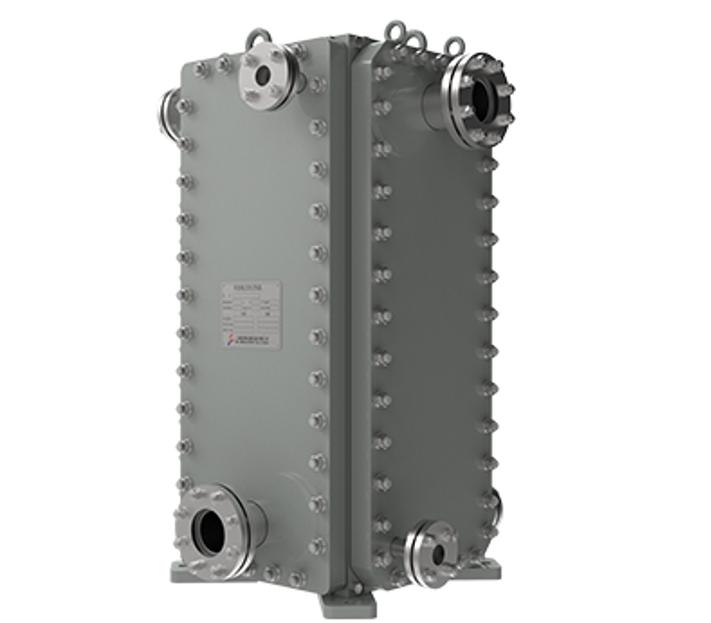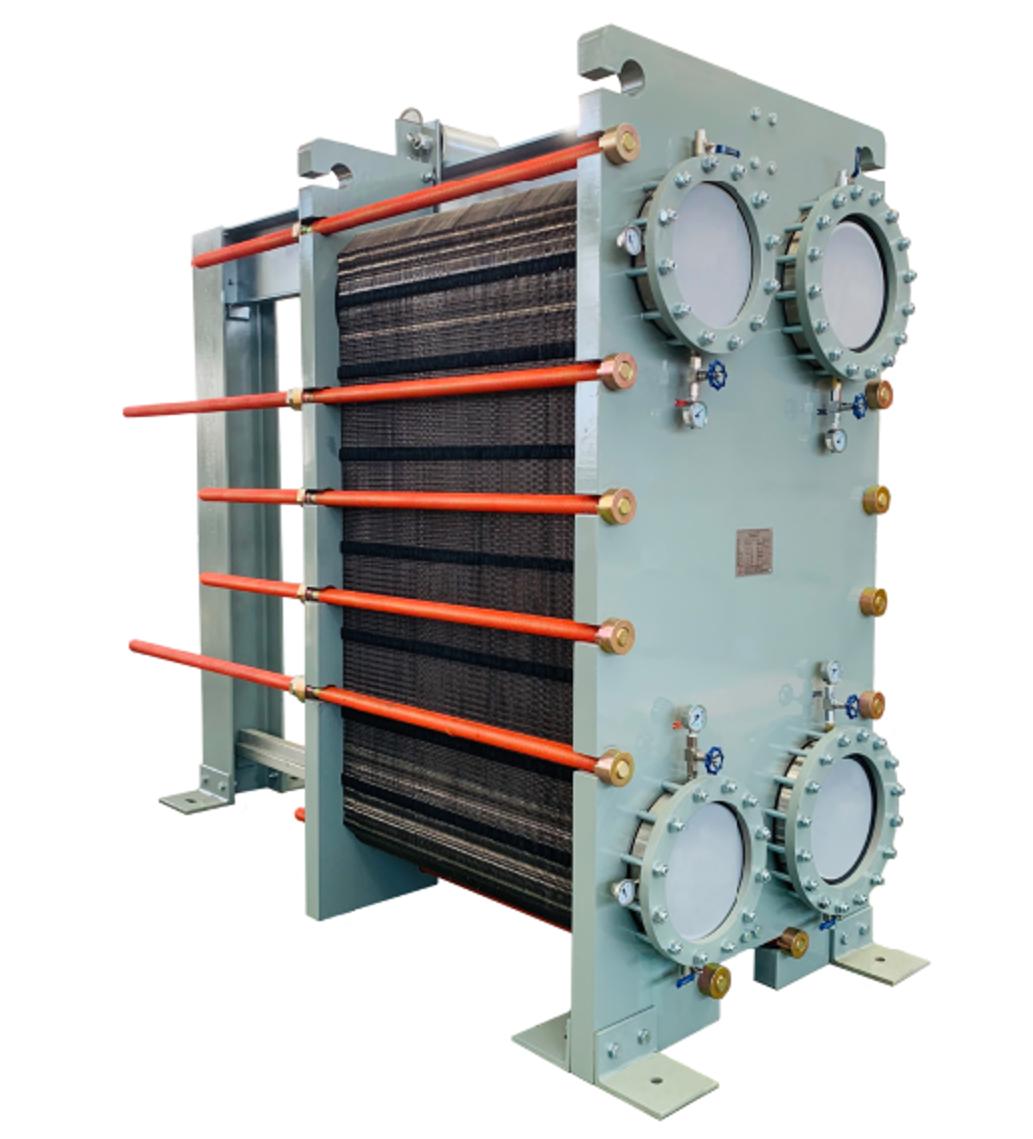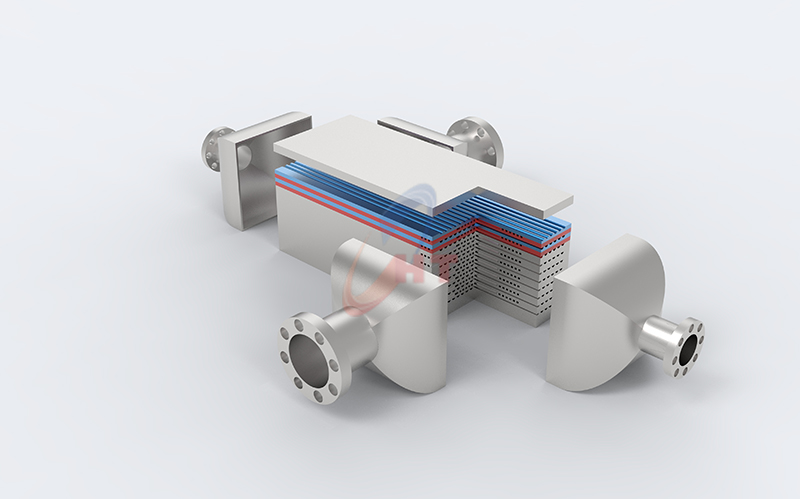Welded vs. Gasketed vs. Printed Circuit Plate Heat Exchangers – Full Comparison
Heat exchangers transfer heat between fluids without mixing them. Among compact, high-efficiency designs are plate heat exchangers, which use metal plates to conduct heat. Three key plate designs – gasketed plate, welded plate, and printed circuit (PCHE) – each use stacked plates but differ in construction. This article compares their structure, performance, maintenance, cost, and uses in the industry. We'll also point out how each fits into sectors like petrochemicals, HVAC, power generation, and more.

Welded Plate Heat Exchangers
Welded plate heat exchangers also use a stack of corrugated plates, but the plates are permanently welded or brazed together at their edges, eliminating gaskets.
SHPHE's HT-Bloc or TP series welded phe exemplify these: a welded plate pack inserted into a sturdy frame with bolted covers. The result is it retains the high heat transfer of plates while gaining much higher pressure and temperature tolerance.
Structure:
A welded plate exchanger is essentially a solid block of metal plates with internal channels. For example, SHPHE's HT-Bloc welded plate combines the high heat transfer efficiency of plate exchangers and the high pressure and temperature resistance of shell-and-tube.
Performance:
Welded plate units bridge the gap between gasketed plates and full shell exchangers.
SHPHE's TP models can tolerate up to ~60 bar and 900 °C (and HT-Bloc types up to 40 bar, -40°C to 400°C). Their thermal performance is still very high – the plate geometry induces excellent heat transfer. These units often achieve very close temperature approaches, similar to gasketed plates, because the internal flow paths can be optimized.
Maintenance:
Here's a key difference: welded units have no replaceable gaskets, so they seldom leak, but they also can't be disassembled easily. If the design allows, users open the exchanger by unbolting the covers – the plate pack lifts out for cleaning.
Cost:
Welded plate heat exchangers cost more than gasketed models. The welding or brazing process, plus heavy-duty materials, adds manufacturing expense. However, they're usually cheaper than PCHEs because they don't require exotic machining.
Industries:
SHPHE highlights welded units in oil refining and LNG service. They also appear in power generation (waste heat recovery, turbine lube oil coolers) and in offshore or marine systems, where ruggedness and leak-tightness are crucial. Any plant requiring efficient heat transfer but with harsh fluids or high-pressure conditions often chooses welded plates.

Gasketed Plate Heat Exchangers
Gasketed plate heat exchangers consist of many thin, corrugated metal plates clamped together in a frame, with rubber or elastomer gaskets sealing the flow channels. The hot and cold fluids flow in alternate channels (usually counter-current), transferring heat through the plates. This modular design – highlighted in SHPHE's documentation – makes them very compact (often 70–90% smaller than shell-tube units).
They are popular in HVAC, refrigeration, food and beverage, chemical processing, and light petrochemical applications, where ease of cleaning and hygiene are prized.
Performance:
They can handle high heating/cooling loads but relatively mild pressures and temperatures compared to welded or PCHE types. A major benefit is the very high surface-area-to-volume ratio (plates can reach 100–200 m²/m³), so the exchanger fits in a small footprint.
Maintenance:
Because they are gasketed and bolted, these exchangers can be disassembled easily. Users can slide out or remove plates to clean them (or use CIP – clean-in-place), and replace worn gaskets when needed. This allows easy disassembly, facilitating straightforward cleaning and maintenance.
The trade-off is that gaskets are worn items: over time they must be inspected or replaced, and a bad seal can cause leaks.
Cost:
Gasketed units are generally the least expensive of the three. They use standard stainless-steel plates and rubber gaskets, with simple bolted frames.
In applications with limited budgets or where disassembly is desired (e.g. breweries, HVAC), gasketed exchangers are common. Their lower price does come with lower pressure ratings, so for very high-pressure or high-temperature duties (e.g. chemical reactors, steam) other designs are chosen instead.
Industries:
Typical uses include heating/cooling water, oils, coolants, and mild chemicals in buildings, food facilities, and process plants.

Printed-Circuit Heat Exchangers (PCHE)
The newest of the three, Printed Circuit Heat Exchangers are made of very thin stainless or nickel-alloy plates, each chemically etched with micro flow channels (like a PCB pattern) and then diffusion-bonded into one solid block. There are no gaskets or joints inside – it's a monolithic core of microchannels. This innovation (developed in the late 20th century) was driven by industries needing compactness and extreme conditions.
Structure:
In a PCHE, plates undergo etching to create intricate microchannel patterns. After stacking the etched plates, they are diffusion-bonded at high temperature and pressure, forming a solid metal block with microscopic passageways.
The result is extremely compact: as tested, PCHEs are four to six times smaller and lighter than conventional shell-and-tube units. Typical channel gaps are on the order of 0.4–4 mm.
Performance:
PCHEs have extreme performance. They handle very high pressures and temperatures – SHPHE notes up to 1,000 bar and 850–900 °C – far beyond what gasketed or welded plates can endure.
Heat transfer efficiency is also outstanding (on the order of 98% effectiveness) because the tiny channels and corrugations force intense turbulence.
For example, PCHEs are used in LNG plants, nuclear reactors, and supercritical CO₂ systems where both pressure and efficiency requirements are extreme.
Maintenance:
Being diffusion-bonded, PCHEs have no moving parts, gaskets, or seals inside.
However, this also means you cannot open or service the internals. If the fine channels foul, cleaning is extremely difficult or impossible; thus PCHEs are restricted to very clean fluids. Systems using PCHEs include fine filters or operate with ultrapure media. Routine maintenance tends to involve only inspecting weld joints and ensuring inlet filtration rather than cleaning the exchanger itself.
Cost:
PCHEs are the highest-cost option. The complex photochemical etching and diffusion-bonding process is expensive, and materials are typically all stainless or exotic alloys (no carbon steel parts).
On the plus side, their compactness can cut costs in other areas: smaller foundations, lighter supports, and lower fluid inventory (which can reduce safety relief requirements). But by unit price alone, printed-circuit units are the most expensive to buy.
Industries:
PCHEs appear where nothing else will do. Early adopters were nuclear power and aerospace (spacecraft and aircraft heat exchangers), and today they are common in nuclear, LNG, hydrocarbon processing, and renewable energy systems, and indeed they see growing use in next-generation energy projects (e.g. small modular reactors, concentrated solar) where efficiency and size are paramount.
How They Compare
| Feature | Gasketed PHE | Welded PHE | PCHE (Printed Circuit Heat Exchanger) |
Construction | Corrugated plates, clamped in a frame | Corrugated plates, welded together (fully or semi-welded) | Chemically etched plates, diffusion-bonded |
Sealing | Elastomeric gaskets between all plates | Welds (internal); some models may have perimeter gaskets | No gaskets (molecular bond) |
Pressure Rating | Low to Moderate (limited by gasket material) | Moderate to High (much higher than gasketed) | Very High (strongest mechanical integrity) |
Temperature Rating | Low to Moderate (limited by gasket material) | Moderate to High (much higher than gasketed) | Very High (can handle extreme temperatures) |
Compactness | Very compact (good surface area/volume) | Very compact (similar to gasketed, slightly less bulky) | Extremely compact (micro-channels, highest surface area/volume) |
Thermal Efficiency | Excellent | Excellent | Excellent (can achieve closer temperature approaches) |
Maintenance/Flexibility | Easy to disassemble, clean, and expand capacity | Fully welded: Difficult/chemical cleaning only. Semi-welded: Some cleanability/flexibility. | Difficult to clean/repair (monobloc design) |
Leakage Risk | Highest (gasket degradation over time) | Very Low (welded joints) | Virtually Zero (diffusion bonded) |
Cost | Lowest initial cost | Medium to High | Highest (specialized manufacturing) |
Typical Fluids | Water, steam, non-corrosive chemicals, food products | Aggressive chemicals, solvents, refrigerants, high-temp fluids | Hydrogen, supercritical CO2, specialized refrigerants, very corrosive/toxic media |
Applications | HVAC, food & beverage, general industrial heating/cooling | Chemical, petrochemical, oil & gas, power generation, refrigeration | Nuclear, aerospace, hydrogen, high-pressure/temperature gas processing |
Related Questions
Q: What's the main difference between gasketed and welded plate exchangers?
The key is sealing. Gasketed exchangers have replaceable rubber gaskets and a bolted frame, so they can be taken apart for cleaning or changing plates. Welded plate exchangers fuse the plates (no gaskets), giving higher pressure/temperature capability but making them harder to service. In short, gasketed plates are more serviceable; welded plates handle harsher conditions.
Q: Why use a printed-circuit heat exchanger instead of a plate or shell?
PCHEs are chosen for extreme requirements. They pack huge heat-transfer areas into a tiny volume and can operate at pressures up to 1,000 bar and temperatures ~850°C. If an application is space-constrained and involves supercritical fluids (like LNG or CO₂), a PCHE can achieve efficiency unattainable by conventional units.
Q: Which type of exchanger is most efficient?
All three types have high thermal efficiency. PCHEs often achieve the highest nominal efficiency (≈98% effectiveness) because of their optimized microchannels.
Q: How do maintenance needs compare?
Gasketed plate exchangers are easiest to clean: you can disassemble them and flush or replace parts.
Printed-circuit exchangers are essentially maintenance-free internally (no gaskets or joints), but they demand clean fluids to avoid clogging and typically need inlet filters.
In summary, the choice among these three types ultimately depends on a careful analysis of the specific operating conditions (temperature, pressure, fluid properties), maintenance requirements, and overall project budget.
If you need further consultation and discussion, please feel free to contact us.
Email: info@shphe.com
WhatsApp /Cell: +86 15201818405




